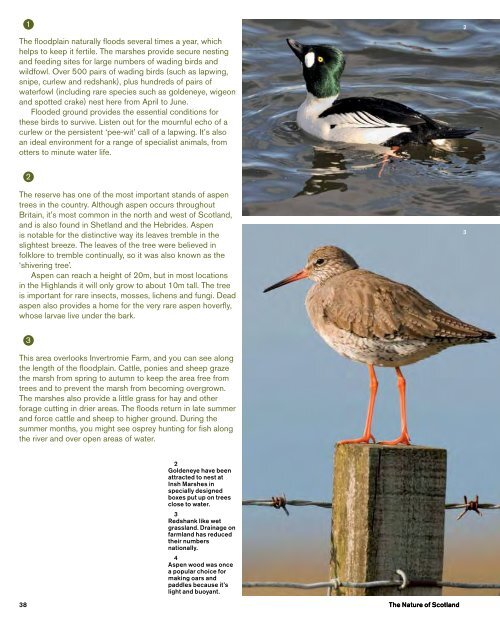Create successful ePaper yourself
Turn your PDF publications into a flip-book with our unique Google optimized e-Paper software.
1<br />
<strong>The</strong> floodplain naturally floods several times a year, which<br />
helps to keep it fertile. <strong>The</strong> marshes provide secure nesting<br />
and feeding sites for large numbers <strong>of</strong> wading birds and<br />
wildfowl. Over 500 pairs <strong>of</strong> wading birds (such as lapwing,<br />
snipe, curlew and redshank), plus hundreds <strong>of</strong> pairs <strong>of</strong><br />
waterfowl (including rare species such as goldeneye, wigeon<br />
and spotted crake) nest here from April to June.<br />
Flooded ground provides the essential conditions for<br />
these birds to survive. Listen out for the mournful echo <strong>of</strong> a<br />
curlew or the persistent ‘pee-wit’ call <strong>of</strong> a lapwing. It’s also<br />
an ideal environment for a range <strong>of</strong> specialist animals, from<br />
otters to minute water life.<br />
2<br />
2<br />
<strong>The</strong> reserve has one <strong>of</strong> the most important stands <strong>of</strong> aspen<br />
trees in the country. Although aspen occurs throughout<br />
Britain, it’s most common in the north and west <strong>of</strong> <strong>Scotland</strong>,<br />
and is also found in Shetland and the Hebrides. Aspen<br />
is notable for the distinctive way its leaves tremble in the<br />
slightest breeze. <strong>The</strong> leaves <strong>of</strong> the tree were believed in<br />
folklore to tremble continually, so it was also known as the<br />
‘shivering tree’.<br />
Aspen can reach a height <strong>of</strong> 20m, but in most locations<br />
in the Highlands it will only grow to about 10m tall. <strong>The</strong> tree<br />
is important for rare insects, mosses, lichens and fungi. Dead<br />
aspen also provides a home for the very rare aspen hoverfly,<br />
whose larvae live under the bark.<br />
3<br />
3<br />
This area overlooks Invertromie Farm, and you can see along<br />
the length <strong>of</strong> the floodplain. Cattle, ponies and sheep graze<br />
the marsh from spring to autumn to keep the area free from<br />
trees and to prevent the marsh from becoming overgrown.<br />
<strong>The</strong> marshes also provide a little grass for hay and other<br />
forage cutting in drier areas. <strong>The</strong> floods return in late summer<br />
and force cattle and sheep to higher ground. During the<br />
summer months, you might see osprey hunting for fish along<br />
the river and over open areas <strong>of</strong> water.<br />
2<br />
Goldeneye have been<br />
attracted to nest at<br />
Insh Marshes in<br />
specially designed<br />
boxes put up on trees<br />
close to water.<br />
3<br />
Redshank like wet<br />
grassland. Drainage on<br />
farmland has reduced<br />
their numbers<br />
nationally.<br />
4<br />
Aspen wood was once<br />
a popular choice for<br />
making oars and<br />
paddles because it’s<br />
light and buoyant.<br />
38 <strong>The</strong> <strong>Nature</strong> <strong>of</strong> <strong>Scotland</strong>

















